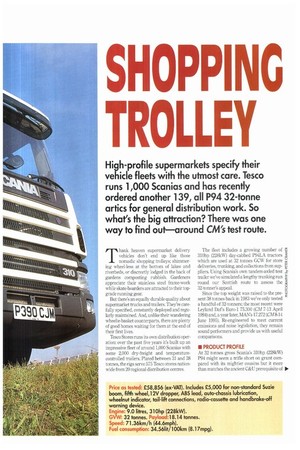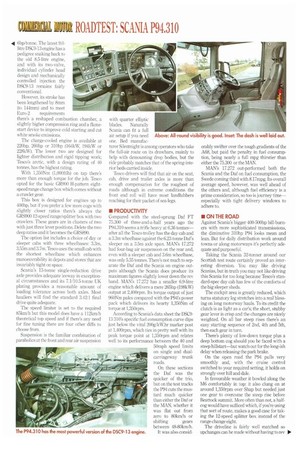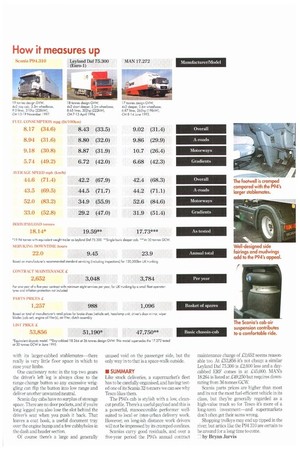COMO EU ROADTEST: SCINIA P94.311)
Page 34

Page 35

Page 36

Page 38

Page 39

If you've noticed an error in this article please click here to report it so we can fix it.
SHOPPING
TROLLEY
High-profile supermarkets specify their vehicle fleets with the utmost care. Tesco runs 1,000 Scanias and has recently ordered another 139, all P94 32-tonne artics for general distribution work. So what's the big attraction? There was one way to find out—around CM'S test route.
Thank heaven supermarket delivery vehicles don't end up like those nomadic shopping trolleys; shimmering wheel-less at the bottom of lakes and riverbeds, or discreetly lodged in the back of gardens composting rubbish. Gardeners appreciate their stainless steel frame-work while skate-boarders are attracted to their topgrade running gear.
But there's an equally durable quality about supermarket trucks and trailers. They're carefully specified, constantly deployed and regularly maintained. And, unlike their wandering wheelie-basket counterparts, there are plenty of good homes waiting for them at the end of their first lives.
Tesco Stores runs its own distribution operation: over the past five years it's built up an impressive fleet of around 1,000 Scanias with some 2,000 dry-freight and temperaturecontrolled trailers. Plated between 31 and 38 tonnes, the rigs serve 575 Tesco stores nationwide from 20 regional distribution centres. The fleet includes a growing number of 310hp (228kW) day-cabbed P94LA tractors which are used at 32 tonnes GOV for store deliveries, trunking, and collections from suppliers. Using Scania's own tandem-axled test trailer we've simulated a lengthy trunking run round our Scottish route to assess the 32-tonner's appeal.
Since the top weight was raised to the present 38 tonnes back in 1983 we've only tested a handful of 32-tormers; the most recent were Leyland Des Euro-1 75.300 (CM 7-13 April 1994) and, a year later, MAN's 17.272 (C11.4 8-14 June 1995). Re-engineered to meet current emissions and noise legislation, they remain sound performers and provide us with useful comparisons.
• PRODUCT PROFILE
At 32 tonnes gross Scania's 310hp (228kW) P94 might seem a trifle short on grunt compared with its mightier cousins but it more than matches the ancient C&U prerequisite of ■ 6hp/tonne. The latest 9.0litre DSC9-13 engine has a pedigree snaking back to the old 8.5-litre engine, and with its two-valve, individual cylinder head design and mechanically controlled injection the DSC9-13 remains fairly conventional.
However, its stroke has been lengthened by 8mm (to 144mm) and to meet Euro-2 requirements there's a reshaped combustion chamber, a slightly higher compression ring and a flamestart device to improve cold starting and cut white smoke emissions.
The charge-cooled engine is available at 220hp, 260hp or 310hp (164kW, 194kW or 228kW). The lower two are designed for lighter distribution and rigid tipping work; Tesco's arctic, with a design rating of 40 tonnes, has the highest rating.
With 1,350Nm (1,000ftlb) on tap there's more than enough torque for the job. Tesco opted for the basic GR900 H-pattern eightspeed range-change box which comes without a crawler gear.
This box is designed for engines up to 400hp, but if you prefer a few more cogs with slightly closer ratios there's always the GRS900 12-speed range/splitter box with two crawlers. These gears are in clusters of two with just three lever positions. Delete the two deep ratios and it becomes the GRS890.
The option list includes a choice of day or sleeper cabs with three wheelbases: 3.3m, 355m and 3.7m. Tesco uses the small cab with the shortest wheelbase which enhances manoeuvrability in depots and stores that are invariably tight on space.
Scania's 13-tonne single-reduction drive axle provides adequate leeway in exceptional circumstances and its 7.1/105-tonne UK plating provides a reasonable amount of loading tolerance across both axles. Most hauliers will find the standard 3.42:1 final drive quite adequate.
The speed limiter is set to the required 85km/h but this model does have a 112km/h theoretical top speed and if there's any need for fine tuning there are four other diffs to choose from.
Suspension is the familiar combination of parabolics at the front and rear air suspension
with quarter elliptic blades. Naturally Scania can fit a full air setup if you need one. Bed manufacturer Silentnight is among operators who take the full-air route on its drawbars, mainly to help with demounting drop bodies, but the ride probably matches that of the spring-interior beds carried inside.
Tesco drivers will find that air on the seat, cab, drive and trailer axles is more than enough compensation for the roughest of roads although in extreme conditions the front end roll will have most landlubbers reaching for their packet of sea-legs.
• PRODUCTIVITY Compared with the steel-sprung Daf FT 75.300 of three-and-a-half years ago the P94.310 seems a trifle heavy at 6.36 tonnes— after all the Tesco trolley has the day cab and a 3.3m wheelbase against the 6.23-tonne Daf's sleeper on a 35m axle span. MAN's 17.272 had four-bag air suspension on the rear and, even with a sleeper cab and 3.6m wheelbase, was only 555 tonnes. There's not much to separate the Daf and the Scania on engine outputs although the Sauna does produce its maximum figures slightly lower down the rev band. MAN's 17.272 has a smaller 6.9-litre engine which delivers a mere 265hp (198kW) output at 2,400rpm. Its torque output of just 960Nm pales compared with the P94's power pack which delivers its hearty 1,350Nm of torque at 1,350rpm.
According to Scania's data sheet the DSC913 310's specific fuel consumption curve dips just below the vital 200g/kWhr marker post at 1,400rpm, which ties in pretty well with its peak torque point at 1,350rpm and relates well to its performance between the 40 and 50mph speed limits on single and dualcarriageway trunk roads.
On these sections the Daf was the quicker of the trio, but on the test tracks the P94 cuts the mustard much quicker than either the Daf or the MAN, whether it was flat out from zero to 80km/h or shifting gears between 48-80km/h. It was also consid erably swifter over the tough gradients of the A68, but paid the penalty in fuel consumption, being nearly a full mpg thirstier than either the 75.300 or the MAN.
MAN's 17.272 out-performed both the Scania and the Daf on fuel consumption, the Swede coming third with 8.17mpg. Its overall average speed, however, was well ahead of the others and, although fuel efficiency is a prime consideration, so too is journey time— especially with tight delivery windows to adhere to.
• ON THE ROAD Against Scania's bigger 400-500hp hill-burners with more sophisticated transmissions, the diminutive 310hp P94 looks mean and lean. But for daily distribution work around towns or along motorways it's perfectly adequate and purposeful.
Taking the Scania 32-tonner around our Scottish test route certainly proved an interesting diversion. You may like driving Scanias, but in truth you may not like driving this Scania for too long because Tesco's standard-spec day cab has few of the comforts of the big sleeper sheds.
The cockpit area is greatly reduced, which turns statutory leg stretches into a real blessing on long motorway hauls. To its credit the clutch is as light as a car's; the short, stubby gear lever is crisp and the changes are nicely weighted. On all bar steep rises there's an easy starting sequence of 2nd, 4th and 5th, then each gear in turn.
There's plenty of low-down torque plus a deep bottom cog should you be faced with a steep hillstart—but watch out for the long-ish delay when releasing the park brake.
On the open road the P94 pulls very smoothly and, with the cruise control switched to your required setting, it holds on strongly over hill and dale.
In favourable weather it bowled along the M6 comfortably in top: it also clung on at around 1,350rpm over Shap but needed just one gear to overcome the steep rise before Beattock summit. More often than not, a halfcog would have sufficed which, if you're using that sort of route, makes a good case for taking the 12-speed splitter box instead of the range-change eight.
The driveline is fairly well matched so upchanges can be made without having to rev I. beyond the most economic banding. Only when shifting up into the high range do the engine revs need pushing to the edge of the green arc to run on at near-maximum torque. Should steep inclines appear you'll need to take it to 1,800rprn or more.
Its quick 0-80km/h time was reflected in each of our five hill climb times. Such gradients certainly tested the cab's insulation, but even when grinding up them on full bore, the noise levels inside never exceeded 72dB(A), making this one of the quietest cabs around. The climb times were all quicker than the Daf 75.300's, although on severe slopes block down-changing demands a certain amount of caution—if you're too quick on the controls, you're liable to discover an unexpected neutral. Like most synchromesh boxes, the GR900 is no Twin Splitter.
On downhill runs the benefits of bringing the exhaust brake in automatically on deceleration are crystal clear. It avoids the driver having to do a tap dance around the floor to find the button, and if you need to haul up fast the foundation brakes are more than up to the task.
Over most of our three-day route the P94 handled well. Its mix of steel and air suspension coped with all but the roughest sections in a smooth, fuss-free manner. Only the narrow downhill B6278 towards Consett unsettled it, causing a deal of movement at the front corners.
The steering remains positive throughout, which is useful for a vehicle that spends much of its time in restricted industrial estates and store loading areas. Tesco's engineers showed a good deal of sense by speccing a coupling boom for the suzies and electrics. This forethought also applies to the raucous alarm that bellows when the driver's door is left open without first applying the parking brake.
Scania includes a check position on the park lever which keeps the unit brakes applied while releasing those on the trailer. Its a useful extra that lets a driver know if the unit can be pushed should the trailer lose all its air. Tesco trucks also have reversing bleepers, but are silent when manoeuvring at night with the lights on.
• CAB COMFORT
Stepping into the cab is easy enough thanks to well-spaced steps, handy rails and a wide entrance. The driver has clear views out front and, this being a fairly low cab, out the sides too. Driving mirrors are large and shapely, although the nearside lenses still don't cover all the lateral angles.
It might be time for European truck manufacturers to follow the Japanese lead and start glazing the lower half of the nearside door for that extra visibility.
The driver's seat is Scania's usual comfy bottom-warmer and it even memorises your setting. The cab heater/ventilation system is well up to the extremes of the British climate, even the inside air is filtered to help asthmatics and hay-fever sufferers.
Perched behind the fully adjustable wheel the P94's dashboard ergonomics are excellent, but below the waistline the driver's footwell region is cramped when compared with its larger-cabbed stablemates-there really is very little floor space in which to ease your limbs.
One cautionary note: in the top two gears the driver's left leg is always close to the range-change button so any excessive wriggling can flip the button into low range and deliver another unwanted neutral.
Scania day cabs have no surplus of stowage space. There are no door pockets, and if you're long legged you also lose the slot behind the driver's seat when you push it back. That leaves a coat hook, a useful document tray over the engine hump and a few cubbyholes in the dash and header section.
Of course there's a large and generally unused void on the passenger side, but the only way in to that is a space-walk outside.
• SUMMARY
Like stock deliveries, a supermarket's fleet has to be carefully organised, and having tested one of its Scania 32-tonners we can see why Tesco likes them.
The P94's cab is stylish with a low, cleancut profile. There's a useful payload and this is a powerful, manoeuvrable performer wellsuited to local or inter-urban delivery work. However, on long-ish distance work drivers will not be impressed by its cramped confines.
Scanias carry good residuals, and over a five-year period the P94's annual contract maintenance charge of £2,652 seems reasonable too. At £53,856 it's not cheap: a similar Leyland Daf 75.300 is £2,600 less and a daycabbed ERF comes in at £45,000. MAN's 18.264 is listed at £49,250 but requires downrating from 36 tonnes GCW.
Scania parts prices are higher than most and its not the most fuel-efficient vehicle in its class, but they're generally regarded as a high-value truck so for Tesco it's more of a long-term investment-and supermarkets don't often get their sums wrong.
Shopping trolleys may end up tipped in the river, but artics like the P94 310 are certain to be around for a long time to come.
by Bryan Jarvis
Price as tested: £58,856 (ex-VAT). Includes £5,000 for non-standard Suzie boom, fifth wheel,] 2V dropper, ABS lead, auto-chassis lubrication, wheelnut indicator, tail-lift connections, radio-cassette and handbrake-off warning device. Engine: 9.0 litres, 310hp (228kW). GVW: 32 tonnes. Payload:18.14 tonnes.
Speed: 71.36km/h (44.6mph).
Fuel consumption: 34.5614/100km (8.17mpg).
DRIVERS' VERDICTS
Every time we trial a heavy truck our testers take it out and invite regular drivers to take it for a short run. We duly took the Scania shopping trolley to the BP truckstop at Crick for a driver's eye view.
Mark Peters was awaiting information on a return load when we met up with him. He drives a Renault G 340 for Norbert Dentressangle out of Portsmouth. "I like the small Scania's lines," was his first reaction. "It's not unlike the Renault Premium. The door handle's in the right place," he observed and once inside he noted that the range change is actuated using a switch. Out on the road he commented: "The gear change is nice and smooth. I can only compare it against the truck I drive; it's a bit notchy on the Renault and this clutch pedal is much lighter than mine as well. The driving position feels a lot lower than I'm used to but visibility is a lot better. There's more window space and the mirrors are bigger and better placed. Steering feels very positive. The engine is so quiet the cab is almost car-like--my engine has quite a distinctive rattle. It's easy enough to keep the revs in the green so the power-to-weight ratio is all right. In fact, the combination of the engine and gearbox is quite forgiving. Operating the exhaust brake on the brake pedal seems to work; the performance of my Renault's exhaust brake is pathetic. The driving position is very comfortable. I can rest my arm on the door and, if the engine hump was a bit higher, it would be like sitting in an armchair. The seat's suspension is quiet; it doesn't bounce and hiss like the Renault's. The dash sweeps around nicely so you can see and reach everything easily but there are far more switch blanks than can ever be used. There's a bit less plastic than in the Renault." As he reversed into an empty slot on the park Peters added: "The steering wheel rim has more grip than mine. I like to look out of the side window when I'm backing up so I only have one hand on the wheel. Because it's smooth on the Renault it's easy for it to slip". He also liked the way the seat lowered to give extra room to get out from behind the wheel. "The steps are bold and non slip," he concluded as he stepped down.
Barrie Walters drives a Scania 93 220 4x2 rigid for Chequer Foods out of Shrewsbury. "The dash doesn't look much different to the older one," was his first reaction. "It puts the dials right in front of you, and there's plenty of room behind the wheel for the larger driver. Is the 12-volt socket standard?" he asked. We said it was, and that two are fitted in sleeper cab versions. Walters dropped into second and moved off effortlessly on the flat. "It's a lot quieter than my 3 Series," he said, "even though this is a day cab. Does the exhaust brake work integrally with the service brakes? I think that's better than having a separate button. The mirrors are a bit chunky. They create a blind spot on the nearside, though, and I expect they're expensive to replace. It feels a bit flat on accelerating up to speed but I could be deceived by the ride and lack of noise, because the engine is quite torquey. It hangs on well on the hills. The front screen is a bit wider and deeper so it gives a better line of vision close up than on the earlier model. I do like this little steering wheel," he added. "It must be smaller than most."
Peters: "The engine is so quiet the cab is almost car-like."
Walters: "It hangs on well on the hills."




























































































































